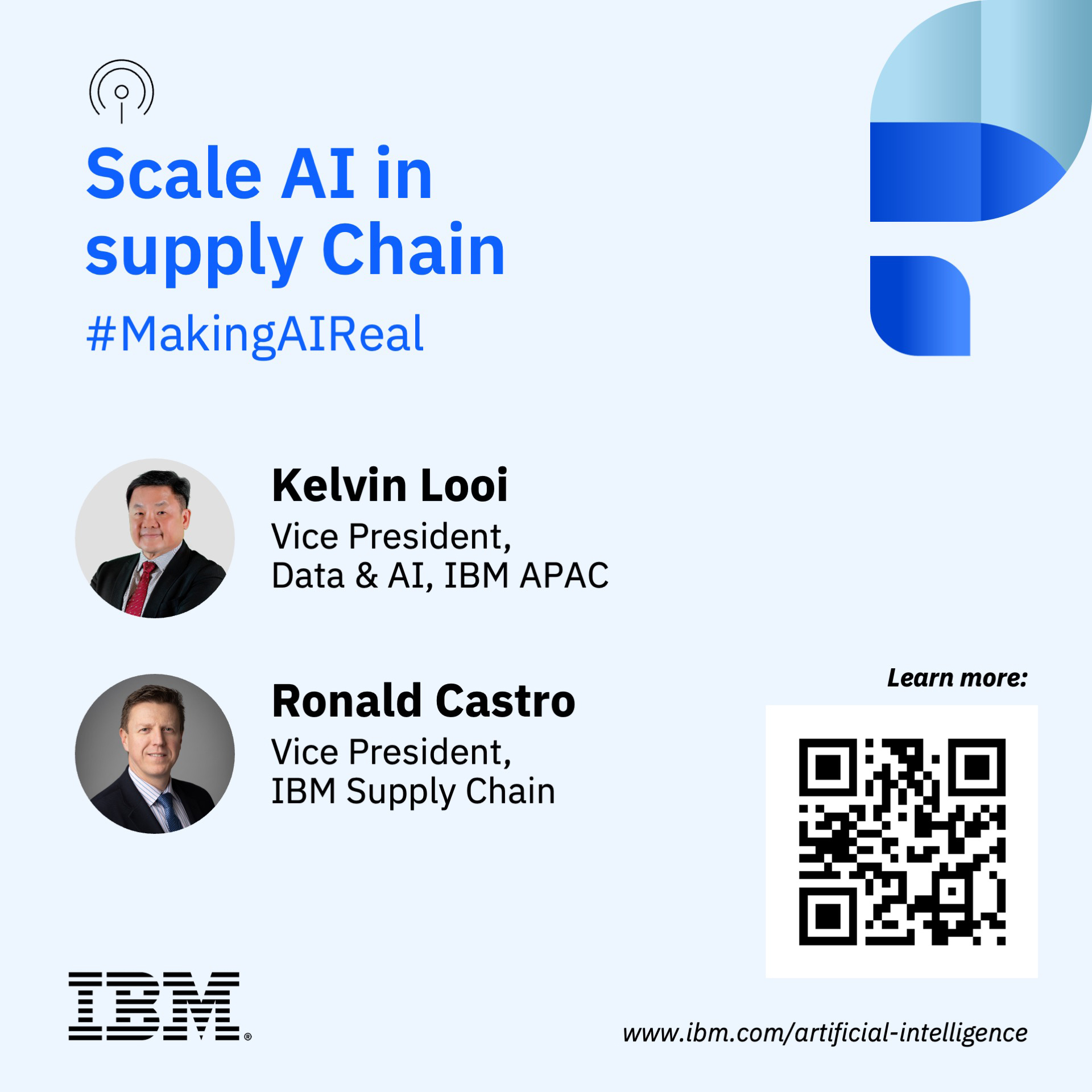Scale AI in Supply Chain
- 0.5
- 1
- 1.25
- 1.5
- 1.75
- 2
Kelvin Looi: Well, it's good to be here. I'm Kelvin Looi, the Vice President of Data and AI Sales for IBM APAC. We are very glad today to have our guest of honor here, Ron Castro, VP of Supply Chain, IBM. Ron, do you want to introduce yourself?
Ronald Castro: Thank you, and it's a pleasure to be here. I lead the IBM global supply chain. In this role, we satisfy orders for clients in over 170 countries. We have employees in over 40 countries, and we deliver all the hardware and software for the company. I have the operational responsibility, but also the very exciting transformational responsibility where we're very much focused on the digital supply chain. I'm very proud of becoming the first inaudible.
Kelvin Looi: So when I think of supply chain, I mean, it's probably the first industry that really adopt AI in a big way. And so I can still remember about 20 years ago seeing factories with robots. Can you tell us more from an IBM perspective how we're using AI in our supply chain?
Ronald Castro: Absolutely. And before I start on the specific cases where we're using AI, as you mentioned, it's been many years and it's been a long journey for us as well. So our key focus was first, was on this journey of harmonizing our processes and instead of running silo and geospecific processes, moving to more of a global integrated enterprise, the GIE model, which helped us really focus on the workflows, what could be simplified, what could be eliminated. And then the next step was being able to get all that digitalized in one single location. So a big focus on data and the data lake and being able to have trusted sources of data. Once we had that, we call that the transparent supply chain. So it became basically a single place for truth in our supply chain. So all the data for management systems, our decisions was coming from this single repository. Once we had all this data in one place, then we started to apply analytics alerts and started to refocus more on how do you manage disruptions in the supply chain? And that's where we started to apply AI with natural language, so you have an interface, a platform approach with natural language. And from there we started to evolve into really optimize around how you manage disruptions, but also how do you have a resilient supply chain that's cost-effective, that delivers to client requirements, et cetera. So to answer your specific question, where do we use AI? I mean, we continue to use AI in our manufacturing floor, in things like visual inspection, acoustics, how we manage quality, track and trace with IoT devices, et cetera. But we're also, with this platform, thinking more holistically of how we apply AI to optimize an end-to-end supply chain, digitalizing our partners, suppliers at the front end, distributors success on the backend, getting insight from our sellers, from opportunity management, et cetera, thinking about workflows, and then starting to implement intelligent workflows. So applying AI to our processes, getting away from more serial processes to more parallel processes where we're looking at embedding AI for better, faster decisions.
Kelvin Looi: Wow, fantastic. From a leader's perspective, before they invest in AI, they're all looking for quantifiable benefits, tangible benefits. Are there any that you can share with the audience?
Ronald Castro: Absolutely, and as I mentioned, it's been a long journey, but we're seeing the fruits of that journey, and we're seeing benefits in freight, how we manage expedites, inventory reductions. And one of the key ones is getting to resolution of issues much faster and getting to better solutions. We've saved over 160 million of costs. Our order fulfillment, even through the depths of the pandemic, were in the 98 to a hundred percent fulfillment rate. So basically we shipped every order that we were able to, to get from our clients. The resolution of issues, 95% faster than before. And we've also spent quite a bit in our procurement processes, digitalizing the processes, embedding AI. 75% of the POs are digital, driven with AI. 91% of the invoices are paid digitally, and 95% of the payments, which at the end means better rebate from our suppliers to us as well. And we've also focused on self-serve capability. With Buy@IBM, for example, saving hundreds of individuals' time, over 2000 man hour times in just the self-serve procurement options.
Kelvin Looi: Wow, fantastic. I mean, I pick up on the 160 million cost reduction and a hundred percent fulfillment rate. In spite of all those, when you meet with leaders around the world, some of them will probably still have objections to adopting AI, and then from your perspective, how do you encourage, what are the opportunities of AI?
Ronald Castro: Yeah, and when I talk to some of the leaders, I think it's becoming a lot more clear now, AI is here to stay and either you play or you're not going to play in the future. But the big question is where do I start? How about the data? Do I have the right skills? Is the culture ready for social drastic change? And I would say a few points here. First of all, the barrier to entry is very low now. We can leverage modern architectures. We can leverage the hybrid cloud, containers, microservices, foundational models. So the barrier to entry is much lower. Data, it's a key focus, so you do need to think about the architecture, the data, whether it's structure on structure, but how are you going to get the data trusted, unbiased? So that's one of the key things is make sure you got the right data, structured data strategy. And then from a skills perspective, it's definitely a focus. I mean, we need to keep modernizing the skills of our teams, but I think it's also a combination of some potential hires as well as leveraging partnerships with others, service providers, et cetera, to complement those skills and be able to move with speed. And I cannot underestimate the value of the culture, the mindset. It's really senior top-down leadership, being able to pivot, being able to accept failures at times because it's not a perfect straight line journey. Leverage things like design thinking, having the agility to change and be able to deploy iterations fairly quickly. We've moved in the past from one or two-year type of implementations to now we deploy capabilities via micro saver services, containers, et cetera, in two, three weeks. So it is thinking this and putting this in the structure of a much more modern architecture.
Kelvin Looi: Yeah. You mentioned about the barrier of entries is pretty much removed and much easier now. On a topic on that, on generative AI and large language model, I mean, that's a buzzword right now and it's one branch of AI. From that perspective, what are some of the foundation action the company should do before they embark on generative AI and large language model?
Ronald Castro: Yeah, no, that's a great question and I did touch on some of those, but I come back to data, data, data, having the transparency, understanding where the data is coming from, et cetera, making sure you have the right architecture from the start. Make sure it's a modern architecture, leverage open architecture. And in our case, we're leveraging a platform approach as well, which gives you a lot of flexibility. And I would say think broadly. Think end-to-end. Think from a process perspective workflows, and how do you apply AI to those workflows and make intelligent workflows work for you? In that same context, think about a lot of the processes today are run serially. When you're thinking about intelligent workflows and embedding AI, you start to operate in a much more of a parallel world where activities can happen much faster in parallel with the AI embedded to make better faster decisions.
Kelvin Looi: Right, right. So when a company now want to invest in AI, the leaders would think that the investment, they want to future-proof it. What are some of the advice you would give to them?
Ronald Castro: I would say the first step is get going. You have to get going. You have to start. No matter where you are in your journey, you need to get going, start, think broadly, be bold, and speed matters. So it is better to move quick and course correct than analysis paralysis. So be bold, move fast. I've touched already on this, but think workflow, think processes. Before you automate, before you apply AI, think is your process even needed? Is that activity needed? So the best simplification is elimination. So eliminate what's not needed, then simplify, and then you automate and then you apply AI, et cetera, and it becomes a much more efficient, more transformational approach. And we've touched a bit on culture, growth mindset, so you need to set the right culture from the top.
Kelvin Looi: Right. Fantastic. I mean, think bold, act fast. People who act fast always win. For people who are just trying to embark on the journey of AI, any last parting words?
Ronald Castro: Yeah, it is a great opportunity to unleash productivity, and it's a great opportunity to unleash productivity at an enterprise level that scales. So my advice is get going, be bold, do it fast, and just get going.
Kelvin Looi: Well, Ron, this is most informative. Thank you very much for your time. And audience, thank you for your time.
Ronald Castro: Thank you very much. Appreciate it.
DESCRIPTION
Making AI Real | Episode 1: Scale AI in Supply Chain
Our first episode from the #MakingAIReal podcast series is out now!
Hosted by Kelvin Looi, Vice President, Data & AI, IBM APAC, hear our speaker Ronald Castro, Vice President of IBM Supply Chain share his thoughts on how they achieved a resilient end-to-end supply chain model using AI for better and faster decisions.
Learn more: https://www.ibm.com/artificial-intelligence



